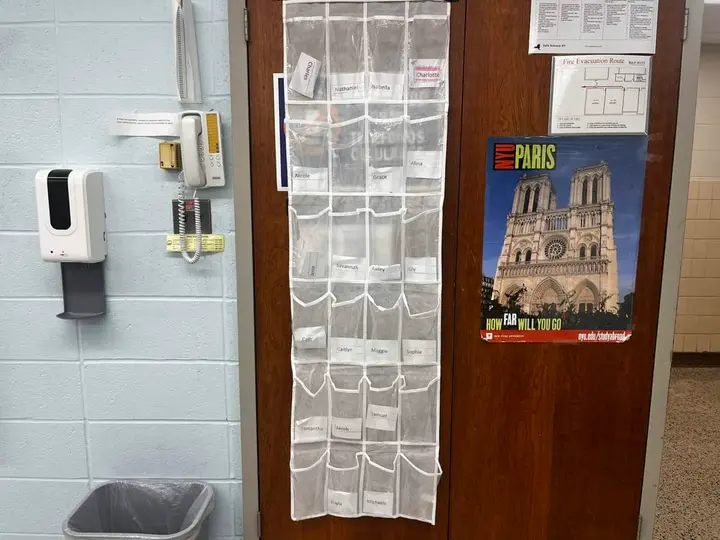Voices: High school cell phone policy “undoubtedly needed”

The Northport Journal is proud to share the voices of our younger community members, as their thoughts and actions will help shape the future. Here high school junior Vivienne Cierski shares a piece on a recently renewed cell phone policy at Northport High School.
This September 6 marked the beginning of a new year at Northport High School and, as is the case after every summer, the school had changed. The floors were shined, the walls repainted, and the graffiti whitewashed. It became clear to the students early on in the day, though, that these cosmetic changes weren’t the only differences in the high school.
Clear, multi-pocketed shoe organizers, previously seen only in crowded closets, were now hanging at every entry point of our classrooms.
This wasn’t a new sight. In the spring of the 2022-23 school year, school administration heard from teachers across the district, at their wits’ end because they had no defense against their students’ cell phone use during class time. Kids were on their phones for entire periods, they said, hiding the devices from teachers underneath desks or, toward the end of the year, simply propping them up on their computers during instruction time.
District administrators and teachers in the high school led a marked campaign against phone use then, brandishing these new shoe organizers turned cell phone holders over their heads, exclaiming with a manic sort of glint in their eye that things were finally going to change. Students had to deposit their mobile devices into the plastic pockets every day before the period started; many loitered around the holder for a few minutes on their phone before begrudgingly slipping it in as the bell rang.
The practice continued – with some classes it lasted for days, others for weeks. Eventually, as the school year continued on, students began to put their phones in the plastic pockets less and less, and the response from the teachers became less and less pronounced. Within a month, the cell phone holders were empty and – in the administration’s eyes – student attention was again compromised.
A few teachers advocated for the holders and continued with their use until the end of the school year. The majority of the building, however, seemed to quietly accept that the biggest competitor for their students’ attention – the cell phone – was pulling ahead.
The struggle for kids’ attention at school is not a new one. There have always been, and will continue to be, myriad distractions in a classroom setting. Some young people are more susceptible to these distractions than others, but what person couldn’t say they haven’t at one time or another allowed their minds to become preoccupied with things outside their present landscapes?
What is critically unique about this particular distraction, however, is the cell phone’s accessibility, and its staying power in the minds of people of all ages. Since the handheld phone’s introduction to the general public in the early 2000s, many studies have been conducted on the impact of the devices on their users (especially young people, who from its onset seemed to gravitate to the mobile phone more than other age groups).
The effects of mobile devices on attention and cognitive capacity have been extensively researched, and the information gathered from these studies has been troubling. We’ve heard of the phenomenon of our shrinking attention spans, how the average Gen Z individual can only concentrate for approximately eight seconds, four seconds less than that of millennials. A different study found office workers could only concentrate on a task for three minutes, noting that it took at least 23 minutes for the brain to refocus after checking a cell phone.
These statistics that are concerning psychologists and educators today are all attributed to the rise of the digital age, our increased screen time as a nation, and the splitting of our collective attention between productive work and our devices.
Searching for a way to combat students being mentally absent in the classroom, this new school year the cell phone policy at Northport High School came back much stronger with vows of it to be more strictly enforced than ever before. Its reinstallment was met, unsurprisingly, with the collective groans of students, and the satisfaction of teachers who have long been struggling to manage cell phone use in the classroom. Attendance was now to be taken through counting the phones in the hanging pockets, and if a student did not comply with the rule, they would be marked absent.
Teachers and administration are happy with the noticeable changes in student attention and participation in class, and students have been able to acclimate and respond to the change, however reluctantly.
Although we can’t know at this point if the cell phone rule will continue at the high school or gradually lose steam over the course of the school year, we can hope that its comment about our society’s overuse of screens will be at least partially reflected in the student body and our own community. However difficult it is to tear ourselves away from these devices designed to grab and hold our attention, for the purposes of our education and our lasting concentration, this new cell phone policy is undoubtedly needed.
Don’t miss a story
Get the latest news delivered to your inbox.








